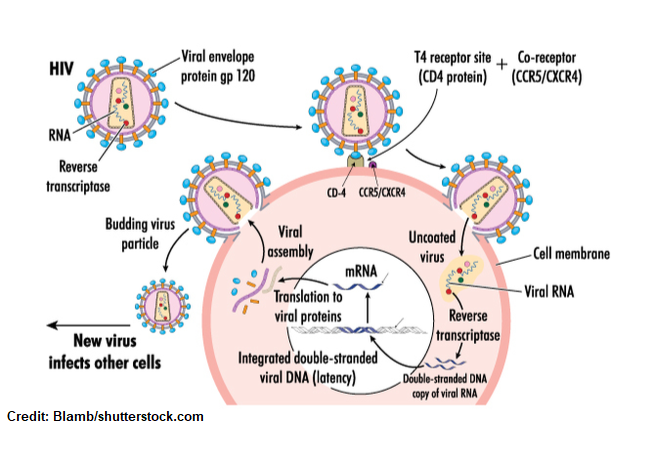The human immunodeficiency virus, more commonly known as HIV, attacks the body’s immune system. This attack is carried out in a series of stages or steps. Knowing these stages can be helpful in understanding how the HIV virus replicates, as well as for understanding the mechanism of action for the the different medications used in antiretroviral therapy (ART), as these can target specific parts of the HIV lifecycle.
Note: you may want to view our comprehensive HIV AIDS review, or take the free HIV AIDS quiz.
Life Cycle of HIV
The life cycle of HIV can be summarized in seven stages or steps, with an eight and final step being maturity and then the repeating of the same steps all over again.

- Step 1: Attachment occurs when the GP120 protein projections make contact and bind with a CD4 receptor. In addition, there is also binding with certain co-receptors called CCR5 or CXCR4 to gain entry into the cell.
- Step 2: Fusion occurs when the virus becomes united with the cell and dumps its content into the cell, which is genetic material (RNA) and enzymes (unpacks it “suitcase”).
- Step 3: Reverse transcription – Now it’s time to set up shop with the goal of getting into the cell’s nucleus and becoming integrated with the cell! Therefore, the single strand of viral RNA needs to turn into viral DNA. The HIV virus brought along with it an enzyme called reverse transcriptase. This enzyme causes the viral RNA to turn into double stranded DNA. This viral DNA moves into the nucleus of the cell.
- Step 4: Integrate – Once inside the nucleus it needs to hijack the cell’s DNA (hence become part of it so it can take control, produce more HIV virus, and kill the cell). To do this, the HIV DNA strand releases another enzyme called integrase, which allows it to become part of the cell’s DNA. So, it’s now integrated into the cell’s DNA.
- Step 5: Replicate – Now that the HIV’s DNA is in control, it starts to use the parts of the hijacked cell to make long chains of the virus.
- Step 6: Assembly – These long chains and other viral material are being assembled and start to move toward the cell’s surface.
- Step 7: Budding – The assembled parts start to grow (hence bud) off the cell wall.
- Step 8: Maturity – Once it has completely grown off the cell’s surface, it pops off. Then protease (an enzyme that cuts the long chain of virus prepping it for maturity) completes its job of maturing the viral material, and a new mature virus is born. The cell that the HIV virus hijacked dies, and this new mature HIV virus has a mission of finding another cell victim with a CD4 receptor. It then starts the whole process again.